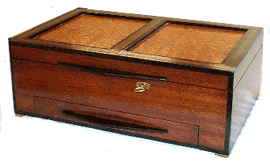
Visit the web site of Refined Edge Furniture Design, and you’ll see some beautifully handcrafted furniture. Mosey on over to White Mountain Design, and you are likely to get a strange feeling of déjà vu as you peer at lovely handmade boxes and hand planes. There’s good reason for that. Both open a door to the craft and passion of one man, Canadian woodworker Norman Pirollo. Why two different web sites?
“I began White Mountain in 1996,” explained Norman, “and latched onto making jewelry boxes. There was a demand locally, but the clientele did not want to pay what it cost to make them. When the Internet came along, I developed a web site and began to get orders for boxes. I love making them, but was uncomfortable with stores charging a 100 percent markup, which is typical for stores.
“At the time, I thought people would be loath to buy from a one-man operation, so I tried to make White Mountain look like a larger company and not an individual maker. Sales were good, and I developed a product line which offered scalable designs, allowing me to customize the proportions of any of my box designs.
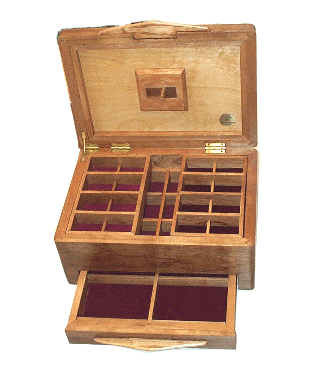
“About five years later, I started to get tired of making boxes, and sales to the U.S., my largest market, started dropping as the exchange rate of Canadian dollars weakened. I decided I would prefer making unique custom furniture pieces, and felt that the best approach was to make a clean cut and start over with a new company name and a new web site devoted entirely to custom-made furniture. I still make jewelry boxes and sell them, but keep the two web sites separate.”
While his woodworking businesses did not come along until the mid-90s, Pirollo’s propensity for working with his hands started early. “My father, who had variously worked as a steam fitter and shoemaker before becoming an entrepreneur, had a basement workshop where he made both metal and wood objects,” he recounted. “I worked with him a lot, and that was where I got my earliest woodworking training.
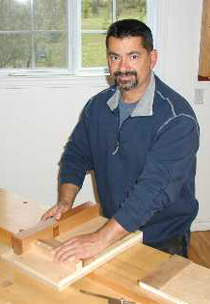
“During my college years, I studied electronic technology and computer science, and worked for a series of firms as a hardware technician and software engineer. In 1986, I had some time and wanted to take an evening course at a local college; one preferably not in my field. People said my hobby should not be my work. The course was on hand tools, making a dovetailed plant stand. It was a Saturday class, and I found myself unable to wait for the week to pass until I could get back to it. That was what made me realize that woodworking should be my vocation, and not merely an avocation.
“That happened to be the first class in a diploma program in cabinetmaking, so I decided to continue and got my diploma in 1993. In 1995, I joined a couple of area craft guilds and entered a few jewelry boxes in a couple of juried shows, but did not get in. That was an eye-opener to me, as I thought I was making a nice product. I crawled back to my shop and started to improve, redesigning the boxes, joinery, and, mostly, improving the finishing. The result was that my boxes improved vastly, and the juried shows started accepting everything I presented.”
“Meanwhile, I set up the White Mountain web site in 1996 as an online business card. I was still trying to cater to the local market, but much to my shock, I started getting calls from all over the U.S. and Europe. I still had a full-time job, and I worked alone, as I still do, and decided that working solely through the Internet was much more feasible. I expanded my product line, but as demand grew, I had to start turning away orders. I was making about 50 or 60 boxes a year, and unfortunately, most sales were seasonal. By 2001, I realized I could either just make jewelry boxes and become very efficient at it, or follow a different path. The thought of assembly line pieces did not appeal to me at all, so I looked further.
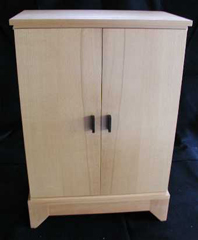
“About that time, a former [James] Krenov student founded a school in this area. Called the Rosewood Studio, it is based on Krenov’s design philosophy. I took several courses there and concluded that this was the type of woodworking I wanted to be doing. There I started learning to make smooth surfaces with planes instead of sandpaper. Prior to that, I had been working primarily with power tools. The school experience convinced me that working with hand tools was a better way to go. The air was cleaner, there was less dust, and it was simply a more satisfying way to work. These days I use power tools for wood prep, but most everything after that is done with hand tools.
“Last year I set up Refined Edge, a web site devoted to custom studio furniture, and just as before, the orders followed. We had a furniture conference at Rosewood Studio last year with a juried show for former students. I presented a beech cabinet, which was the very first piece of my Refined Edge company. The response I got from a wide range of well-known guest speakers boosted my morale, and convinced me that this was what I should be doing. At the moment, I still spend one quarter of my time working for the software industry and the rest doing woodworking. I still make a few jewelry boxes, mostly for the Christmas season, but my main focus, as far as woodworking is concerned, is furniture.”
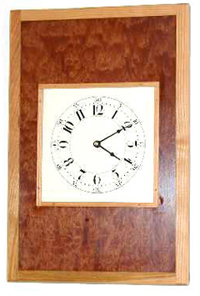
Not content to simply learn from others, Norman decided he should pass it on by teaching. “In 1998 I created a modular woodworking course on CD-ROM,” Norman told me. “It is essentially an interactive book on CD covering everything from lumber selection and safety to joinery and finishing. At the end of every module there is an interactive question and answer session to reinforce what you have learned. I advertise it in a few woodworking magazines, and have sold thousands of copies over the years.”
He also has posted a few articles on his White Mountain web site and on the WoodCentral article archive, including one on shooting boards, and one outlining his clever downdraft table cum shop air filter that doubles as a table saw extension. But perhaps even more valuable than his articles is this succinct bit of advice that he offered. After all, it is a wise teacher who follows his own council.
“If you are tired of your day job,” Pirollo advises, “do what I did. Pursue your passion instead.”







